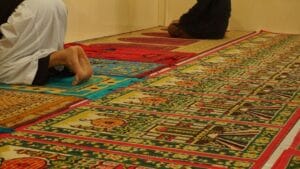Introduction
Teaching children about Salah, the Islamic practice of prayer, is an essential aspect of fostering their spiritual growth. In the USA, where diverse cultures and religions coexist, teaching Salah can present unique challenges and opportunities. This guide aims to provide parents with engaging methods to teach their children about Salah, ensuring they understand its significance and develop a lifelong habit of prayer.
Understanding Salah
Salah, also known as Namaz, is one of the five pillars of Islam and is performed five times a day. It serves as a direct link between the believer and Allah. Understanding the importance of Salah is crucial for children, as it can instill a sense of discipline, connection to faith, and community.
The Significance of Salah
- Obligation: Salah is a mandatory act for every Muslim, symbolizing obedience to Allah.
- Spiritual Connection: It helps establish a personal relationship with Allah, enhancing spiritual growth.
- Community Bonding: Praying in congregation fosters a sense of community and belonging.
- Moral Development: Regular prayers encourage children to develop a sense of responsibility and discipline.
Engaging Techniques to Teach Salah
Incorporating fun and interactive methods can significantly enhance a child’s understanding and appreciation of Salah. Here are some effective techniques to consider:
1. Storytelling
Stories from the Quran and Hadith can captivate children’s interest. Share stories that emphasize the importance of Salah and its benefits. For example:
- The Story of Prophet Ibrahim (AS): Illustrate his devotion and the significance of prayer in his life.
- The Night of Ascension (Isra and Miraj): Teach children about the commandment of Salah and its divine origins.
2. Interactive Learning
Encourage children to learn through interactive methods:
- Role-Playing: Set up a mini mosque at home and allow children to practice praying.
- Prayer Charts: Create colorful charts that outline the steps of Salah, including the actions and recitations.
3. Visual Aids
Utilize visual aids to make the learning process more engaging:
- Videos: Use educational videos that demonstrate how to perform Salah correctly.
- Illustrated Books: Invest in books that depict Salah in an engaging manner, tailored for children.
4. Celebrate Achievements
Encouragement plays a vital role in learning. Celebrate milestones:
- Sticker Charts: Create a chart where children can place stickers for every prayer they perform.
- Rewards: Consider rewarding consistent prayer practices with small prizes.
5. Family Involvement
Involve the entire family in the learning process:
- Group Prayers: Pray together as a family, especially during important occasions like Jummah (Friday prayers).
- Discussions: Engage in discussions about the significance of Salah and how it affects daily life.
6. Use of Technology
In today’s digital age, technology can be a useful tool for teaching Salah:
- Prayer Apps: Utilize apps that provide reminders and guidance on Salah.
- Online Classes: Enroll children in online classes that focus on Islamic education.
Creating a Positive Environment
To foster a love for Salah, creating a supportive environment at home is essential. Here are some strategies:
1. Set a Routine
Establish a regular prayer schedule to help children incorporate Salah into their daily lives:
- Consistent Timing: Perform prayers at the same time each day to build a habit.
- Preparation: Prepare children for prayer by ensuring they are aware of prayer times.
2. Lead by Example
Children often imitate their parents. Demonstrating your commitment to Salah will encourage them to follow suit:
- Visible Practice: Pray visibly so that children can observe and learn.
- Open Discussions: Talk about your experiences and feelings during Salah to inspire them.
3. Address Questions
Children are naturally curious. Encourage them to ask questions about Salah and spirituality:
- Open Dialogue: Create a safe space for them to express their thoughts and doubts.
- Provide Clear Answers: Offer age-appropriate explanations to their inquiries.
4. Incorporate Cultural Elements
In America, blending cultural elements can make Salah more relatable:
- Community Events: Participate in local Islamic events or activities that focus on Salah.
- Islamic Art: Use Islamic art and calligraphy to decorate prayer spaces at home.
Practical Examples and Real-World Applications
Here are some practical applications of the techniques mentioned above:
Example 1: Creating a Prayer Space
Designate a specific area in your home for Salah. This space should be:
- Quiet: Ensure it’s free from distractions.
- Decorated: Include Islamic art, prayer mats, and a Quran.
- Welcoming: Make it a comfortable and inviting area for your children.
Example 2: Salah Workshops
Organize or attend workshops focused on teaching Salah to children. These workshops can include:
- Interactive Sessions: Hands-on activities to practice Salah.
- Guest Speakers: Invite knowledgeable individuals to share their experiences.
Example 3: Salah and Nature
Combine outdoor activities with spiritual lessons. For instance:
- Nature Walks: Discuss how nature reflects Allah’s creation and the importance of prayer in appreciating it.
- Outdoor Prayers: Occasionally pray outdoors to connect with Allah in nature.
Frequently Asked Questions (FAQ)
What is Salah?
Salah is the Islamic practice of ritual prayer performed five times a day. It is a fundamental act of worship that connects Muslims with Allah and serves as a reminder of their faith and duties.
How does Salah benefit children?
Salah benefits children by instilling a sense of discipline, enhancing their spiritual connection, promoting moral values, and fostering a strong sense of community. Regular prayer can also improve focus and concentration in their daily lives.
Why is it important to teach Salah at a young age?
Teaching Salah at a young age allows children to develop a strong foundation in their faith. It helps them understand the significance of prayer and encourages them to incorporate it into their daily routines, leading to a lifelong habit of worship.
How can I make Salah enjoyable for my child?
Making Salah enjoyable can be achieved through storytelling, interactive learning, visual aids, and family involvement. Celebrating achievements and incorporating technology can also enhance the experience, making it more engaging for children.
What resources are available for teaching Salah?
There are numerous resources available for teaching Salah, including:
- Books: Illustrated books that explain Salah in a child-friendly manner.
- Apps: Mobile applications that provide guidance and reminders for prayer times.
- Online Courses: Educational platforms that offer courses focused on Islamic teachings for children.
Conclusion
Teaching children about Salah is a rewarding journey that requires patience, creativity, and consistent effort. By employing engaging methods and creating a supportive environment, parents can foster a deep understanding and appreciation for this essential act of worship. Remember to celebrate their milestones, involve the family, and utilize available resources to enhance their learning experience. Ultimately, nurturing a love for Salah will not only benefit children spiritually but will also strengthen their connection to their faith and community.














Post Comment